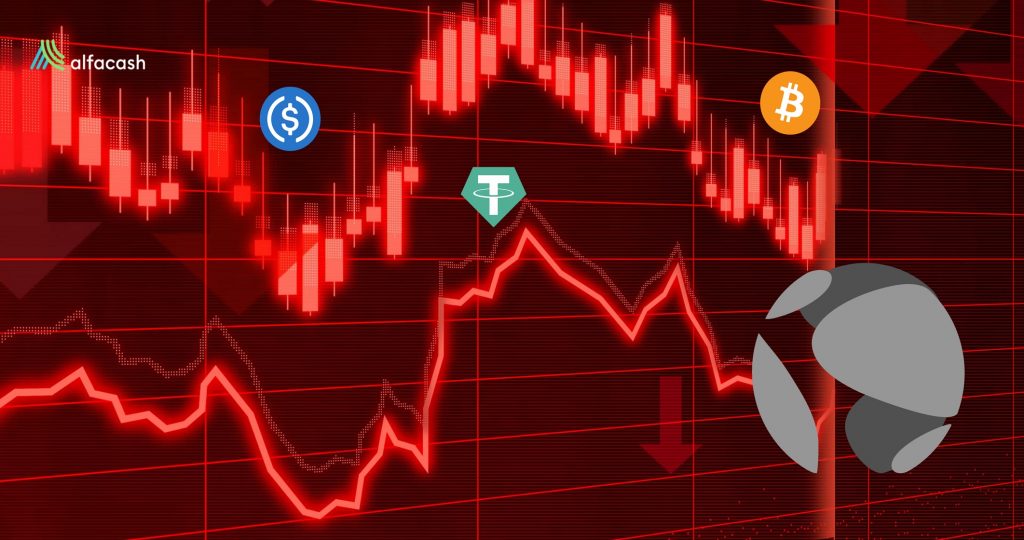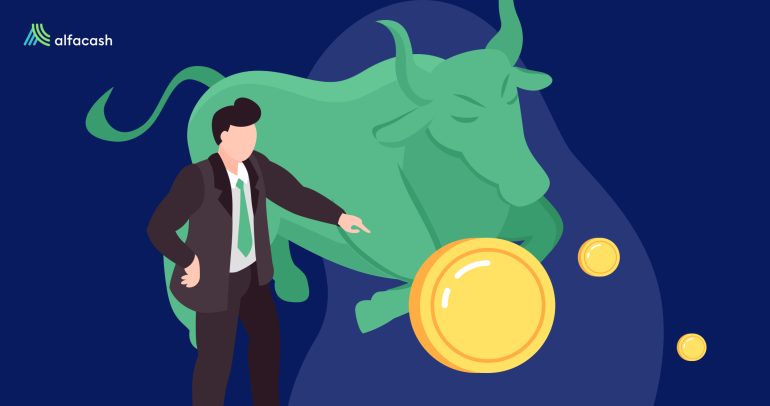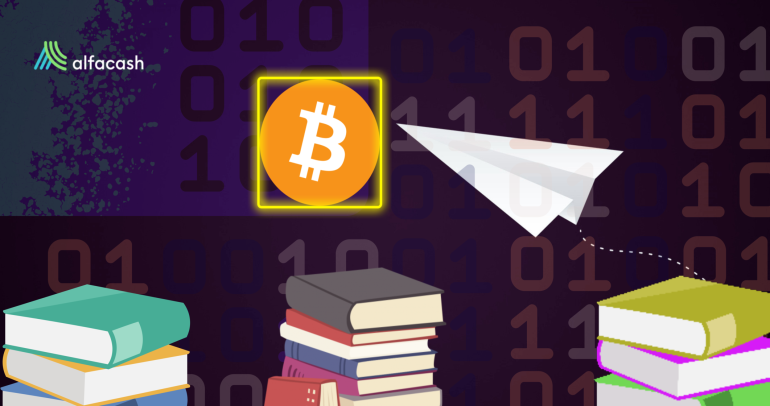We’ve been passing through a bearish market in crypto, and it’s been a familiar feeling. Been there, done that. However, the recent Terra (LUNA) total collapse in the wake of the de-pegging of its native stablecoin, TerraUSD (UST), is likely something else. They lost 99% in a few days, which traduces to erasing billions of dollars from investors worldwide.
It’s hard to say what really happened to Terra and UST. This is a whole blockchain ecosystem with the stablecoin UST as an epicenter —until now, at least. It was founded by Daniel Shin and Do Kwon back in 2018, but, since the last year, experienced huge and quick growth. In mid-May 2021, every LUNA was traded at $16. It didn’t stop until its last All-Time-High (ATH) barely a month ago: over $119 per token (+643% in a year, by CMC).

Meanwhile, UST, as promised, maintained its peg to the U.S. Dollar (USD) in a 1:1 ratio. The methodology to do that wasn’t the most popular among stablecoins, though. UST is (probably was) an algorithmic stablecoin, which means no collateral to back it up. Instead, the price gained its stability from the investors and the code themselves.
Ako oni vysvetlil, “TerraUSD is an algorithmic stablecoin, where the cost of minting is equal to the face value of the stablecoins minted — in order to mint 1 TerraUSD, only $1 worth of the reserve asset ($LUNA) must be burned.” Or, in other words, UST kept its 1 USD value by issuing and burning LUNA coins. Until May 8, 2022, that’s it.
Terra’s deadly spiral
The FUD (Fear, Uncertainty, and Doubt) spread among UST and LUNA investors when the stablecoin started to lose its 1 USD peg on May 8. Back then, around 286 million UST were sold and the system was full of short positions. The whales were pulling off a big sell-off, and the market panicked. Anchor Protocol, the most-used DeFi platform on Terra, had withdrawals for over $2 billion in 24 hours.
For the next day, UST was at $0.7 (around 30% less than it should be). On May 11, the price decreased to $0.3 (70% less). By the time of writing, UST is at $0.1 (90% less). LUNA was dragged into the deadly spiral, losing almost of its value. Bottom line: UST and LUNA had more sales pressure than they could handle. The investors lost trust in a system that previously worked, and for that, it collapsed. Why did all of this happen?
As always, there are some theories around. While some blame the protocol itself for not having any plan for this, some others are blaming the hedge fund Citadel and investment firm Blackrock for manipulating the market against Terra to get profits.
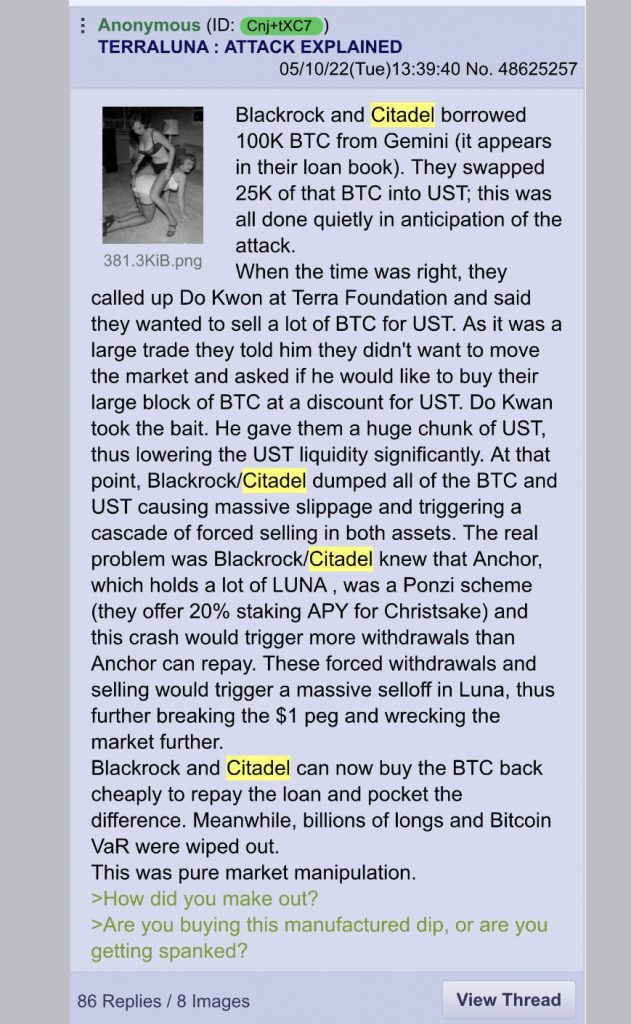
Others talk about no-named OTC (Over-the-Counter) whales colluding to attack Terra and UST. This way, they’d been accumulating $1 billion UST, borrowed $3 billion in BTC, started to spread FUD, and then sold everything to increase the panic and destabilize UST and LUNA.
Beyond the hypotheses
Of course, these are only theories. What we know for sure is that not even the Luna Foundation could save UST. They lent $1.5 billion to market makers on May 9 to try and recover the stablecoin peg, but it didn’t work. Since then, this Proof-of-Stake (PoS) blockchain has been halted twice by validators (thus, stopping the creation of new blocks and transactions). It’s back online now, but the future is looking hard for Terra.
An awful lot of investors lost hundreds, thousands, and even millions of dollars in LUNA and UST. The TerraLUNA subreddit is full of tragic stories now. People lost life savings, homes, hopes, and even their own lives. A pinned message on the top indicates some helpline numbers (against suicide) and warns all the investors:
“This is one of the reasons why you shouldn’t invest money that you can’t afford to lose (…) Here I like to emphasize again, don’t invest money you need to survive/live the next weeks/months/even a year. Don’t invest in the hopes of having more next month. This is a very volatile market nobody knows what’s gonna happen. In the long term it definitely will pay off, but short term it can make you feel like shit and I hope you understand that you are not alone in this.”
In the meantime, over eight crypto exchanges vymazali LUNA and UST temporarily or definitely. This, sadly, means that investors have very limited or no options now to exchange whatever had left of their LUNA and UST stashes.
Possible solutions
After a while outside social media, Do Kwon came back to Twitter to apologize and make a new recovering proposal for Terra. Previously, some users proposed to fork the network and restore it before the UST de-pegging event. This would essentially “erase” all the recent chain history (and chaos) that ensued, much like the Ethereum developers did back in 2016 with The DAO —and which caused enough polemics for the network to split into ETH and Ethereum Classic (ETC).

Do Kwon thinks that isn’t a good option for Terra. Instead, he’s aiming to rescue the blockchain, without the stablecoin. In the process, he hopes to compensate all the current LUNA and UST holders with newly-minted LUNA tokens. Validators would reset the network ownership to 1 billion.
From these newly-minted LUNA tokens, 40% would be destined to the LUNA holders before the de-pegging event. Another 40% would go to UST holders at the time of the network update, 10% to LUNA holders at the moment of the chain halt, and 10% for future development. As for the future of Terra, Do Kwon commented:
“(…) While UST has not been successful, the Terra community will find ways of iterating on the idea at some point in the future. But the priority now should be to preserve this amazing ecosystem and to make as many users and builders as possible. I hope the community can achieve speedy consensus on how to revive the Terra ecosystem. I’ll always be here.”
Panic for regulators: that it means for crypto
The Terra and UST case has been a call to action to regulators worldwide. Of course, they were already preparing their own rules pre stablecoiny, but this could accelerate the process by far. Just recently, U.S. Treasury Secretary Janet Yellen addressed the issue directly, urging Congress to prepare a new set of rules for stablecoins before the end of this year. She komentoval:
“I wouldn’t characterize it at this scale as a real threat to financial stability but they’re growing very rapidly. They present the same kind of risks that we have known for centuries in connection with bank runs.”
Meanwhile, the European Union (EU) and the United Kingdom (UK) are developing their own regulatory frames. Indeed, last April, the UK government oznámil that they’re interested in adopting stablecoins, but only under full regulatory supervision. “Unbacked cryptoassets” (such as UST) wouldn’t welcome, as a government spokesperson declared to CNBC.

The European Commission may take harder measures. According to intel gathered by CoinDesk, they’re considering banning large-scale stablecoins inside their territory. This points to coins with over $211 million in transactions per day —which include Tether (USDT), USD Coin (USDC), and DAI.
However, this is still a raw proposal. They also considering reclassifying stablecoins and subjecting them to direct supervision of the European Banking Authority. It’s very likely that other jurisdictions worldwide follow the examples of the US and EU, whichever they end up being.
Can this happen to other currencies, like USDT or BTC?
This kind of event can happen again to any other algorithmic stablecoin if the team behind them doesn’t take enough measures to prevent it. That said, we can’t assure that big collateralized stablecoins like Tether (USDT) and USD Coin (USDC) won’t have any problems in the future.
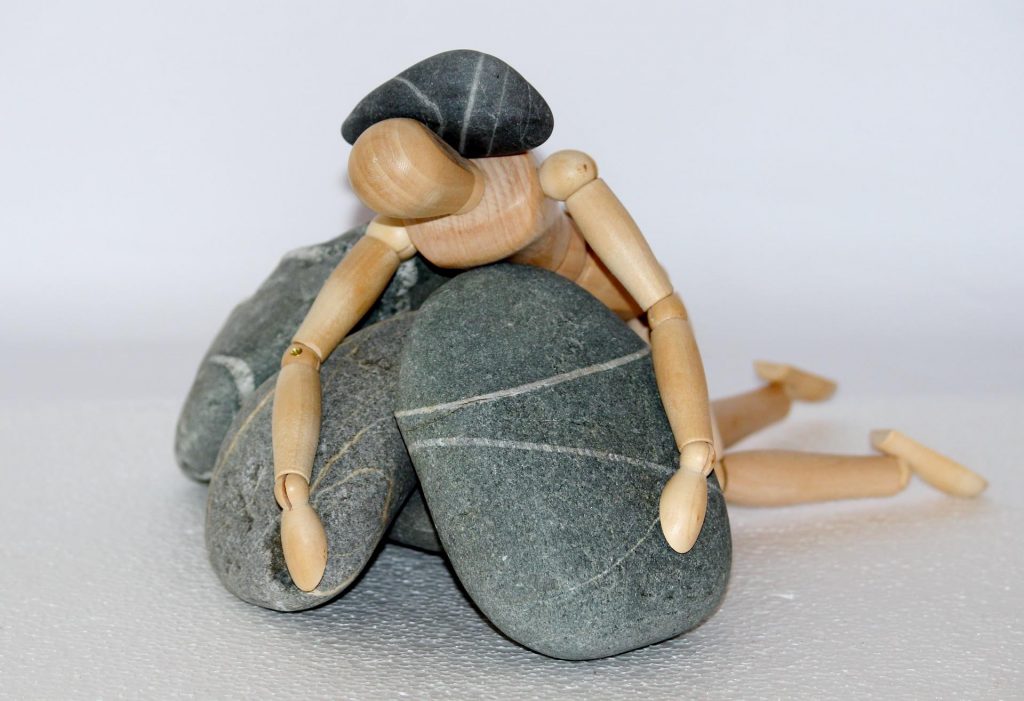
Tether, for example, it’s been widely criticized, questioned, a dokonca aj pokutu about its reserves. At first, its creators claimed that it was “fully backed” by USD cash on bank accounts owned by the company. However, this isn’t the case now.
Podľa jeho posledného a stručná správa about its reserves, Tether is mostly backed by commercial papers (over 65%), secured loans (12%), corporate bonds, funds, and precious metals (9%), and only 3.6% in USD cash. The collateral is fully controlled by Tether Limited and Bitfinex.
This could raise further issues with regulators in the near future. To its credit, though, Tether has survived for over eight years and it always recovered against the odds.
About Bitcoin
Bitcoin is entirely another world. Its internal system (Proof-of-Work) is entirely different from stablecoins, and its value doesn’t come from any collateral or algorithm. It comes only from its own utility, and supply and demand. Ethereum (ETH) and other major altcoins share that last part too. And that doesn’t mean they can’t be manipulated.
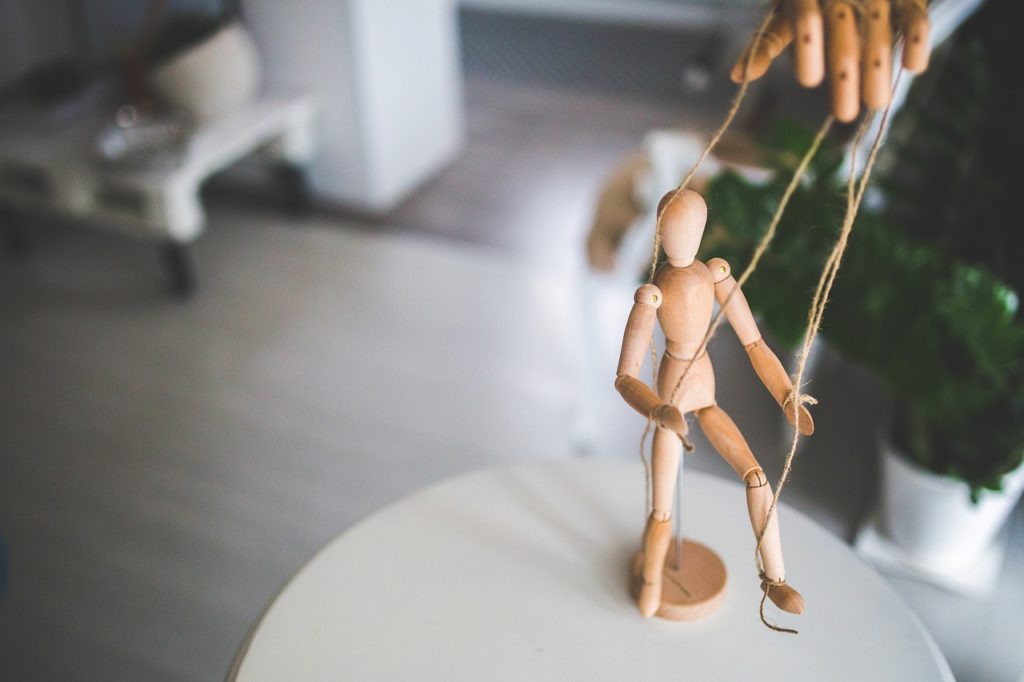
All the markets in the world (not only crypto) can be manipulated up and down: that’s why regulations exist. Fake (and even real) news has the power to urge in-masse selling or buying, and it’s difficult to change that. So, can BTC go to zero? Unlikely, given its current size and uses. But it can, and it will change its price often. To your favor, or against, without any previous notice.
Cryptocurrencies are volatile and risky. They can also be very useful and profitable, yes, but you should never bet the funds you need to survive. That’s the Terra and UST lesson for all of us.
Wanna trade USDT, BTC, a iné žetóny? Ty to dokážeš bezpečne na Alfacash! A nezabudnite, že o tomto a o mnohých ďalších veciach hovoríme na našich sociálnych sieťach.
Telegram * Instagram * YouTube *Facebook * Vkontakte
